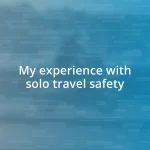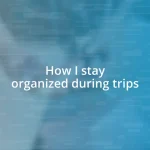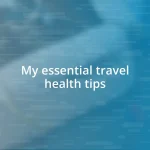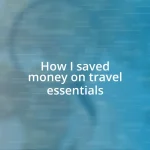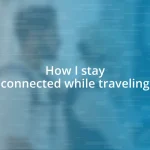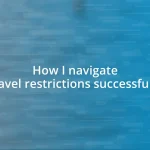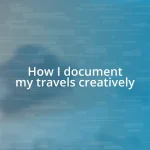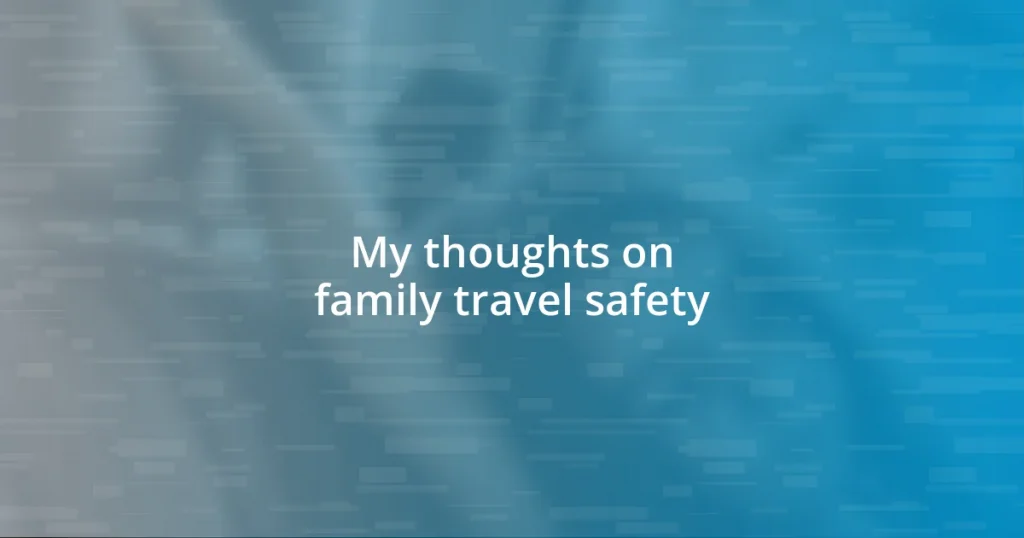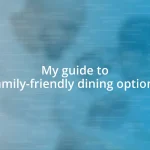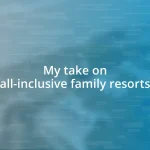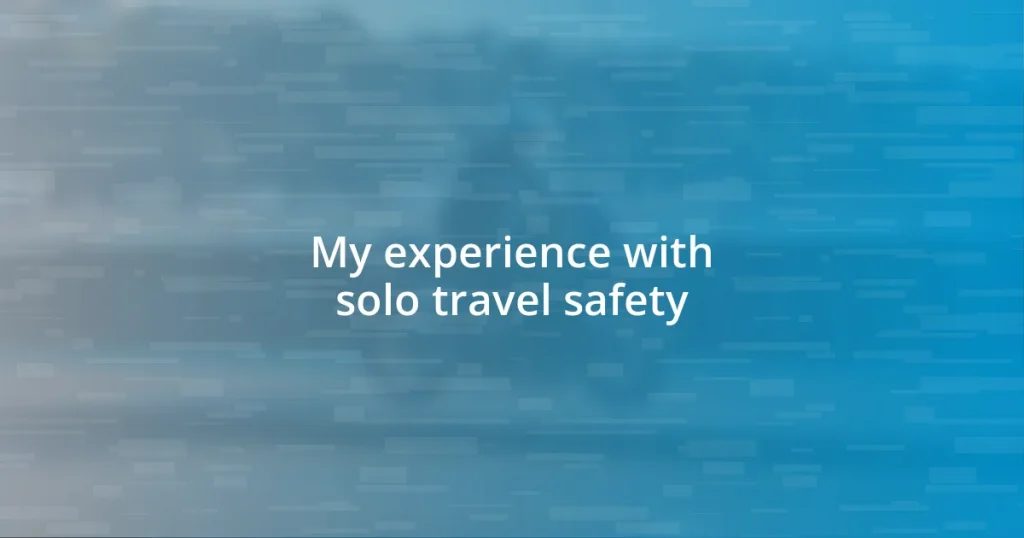Key takeaways:
- Understanding and assessing safety risks at travel destinations is crucial for family safety, including evaluating local healthcare access and cultural norms.
- Preparing an emergency travel kit with essential items and fostering a mindset of adaptability can help manage unexpected situations during trips.
- Engaging children in safety awareness through interactive activities and discussions empowers them and enhances family preparedness for travel-related challenges.
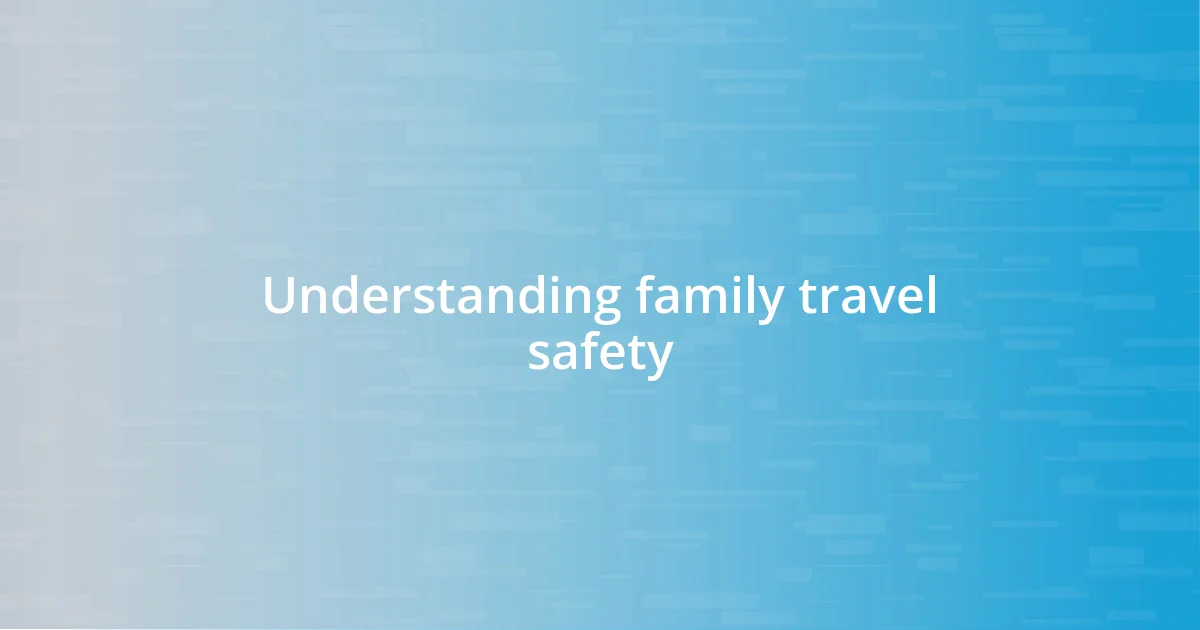
Understanding family travel safety
When I think about family travel safety, it immediately brings to mind a trip we took to the mountains a few years back. As we unpacked the car, I remember feeling a mix of excitement and anxiety, knowing that keeping everyone safe in a new environment was my responsibility. The thrill of adventure often overshadows the possible risks; this is where understanding safety becomes crucial.
Have you ever considered how the unfamiliar places we explore can change our perception of safety? I certainly have. During that same trip, we encountered a hiking trail that looked inviting yet posed real hazards—steep drop-offs and limited cellphone service. It was a moment that reminded me that safety guidelines aren’t just suggestions; they’re essential. I learned to always prepare by researching our destination and understanding the inherent risks before stepping foot on any trail or into new experiences.
I also reflect on how safety measures can vary significantly depending on where you are. For example, traveling internationally, I was struck by the different safety protocols in place—like how some countries require child safety seats while others don’t even mention them. It really makes you think: what practices can we adopt to ensure our family’s safety, regardless of our destination? It’s vital to navigate these differences with an open mind and a commitment to safeguarding our loved ones in any situation.
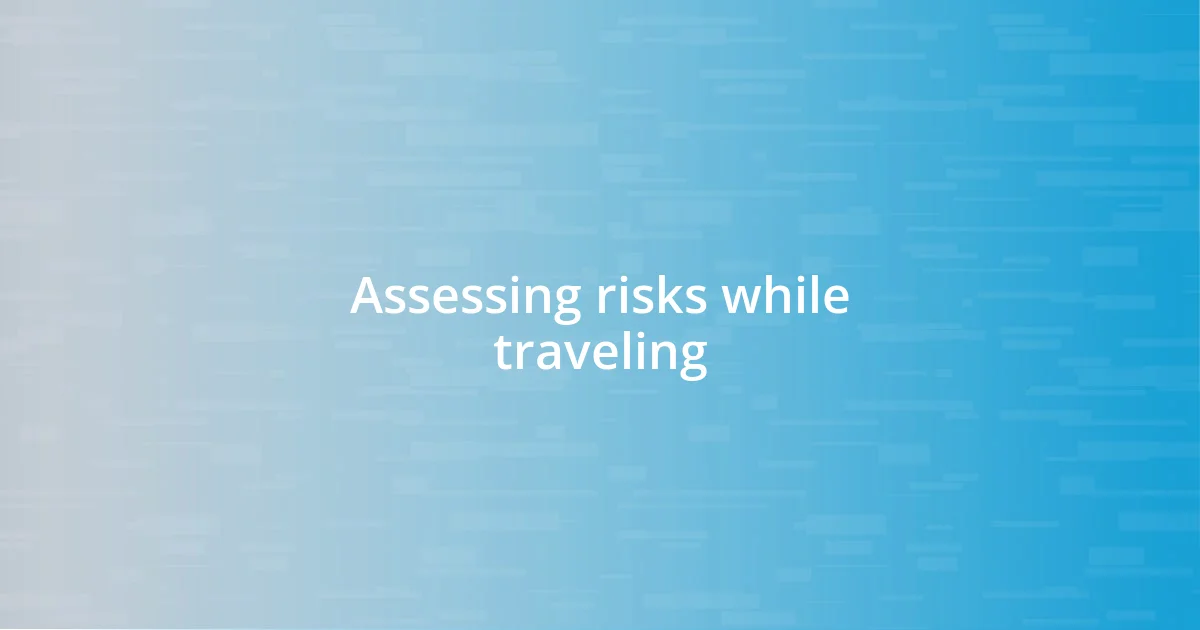
Assessing risks while traveling
Assessing risks while traveling begins with a critical mindset. I remember a family trip to a bustling city where I quickly realized how easy it was to become disoriented and overwhelmed. One wrong turn in a crowded market could lead to lost children or valuable belongings. It’s these moments that require us to stay vigilant and establish clear rules with our family about where to meet if we get separated.
When traveling, I often use a simple checklist to evaluate various risks at our destination. For instance, I assess local healthcare services, traffic conditions, and even cultural norms. During a road trip across a different country, I was astonished to find out that certain areas lacked proper medical facilities, which made me more cautious about my family’s outdoor activities. Understanding these factors can transform travel from just an adventure into a well-planned experience.
The beauty of assessing risks is that it invites discussion within the family. I remember sitting with my kids, showing them maps and discussing potential pitfalls of our plans. It fostered a sense of teamwork and awareness that makes travel more enriching. By being upfront about safety, we formed a bond centered on mutual respect and responsibility.
| Risk Factor | Importance Level |
|---|---|
| Local Healthcare Access | High |
| Traffic Conditions | Medium |
| Cultural Norms | Medium |
| Emergency Contacts | High |
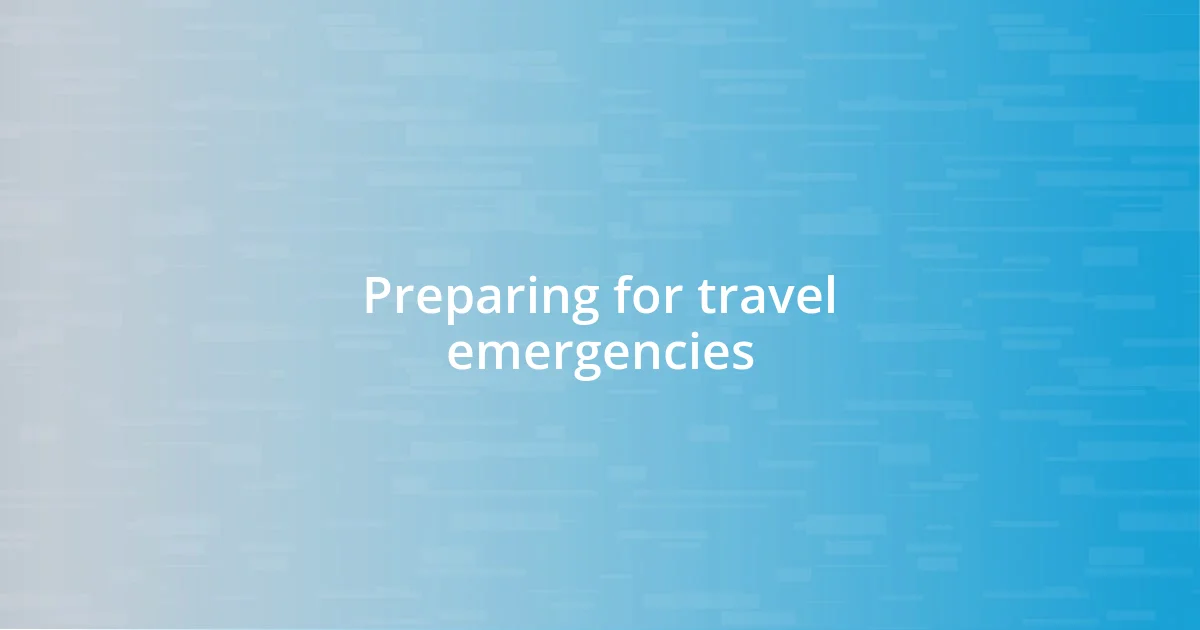
Preparing for travel emergencies
When preparing for travel emergencies, I often think of the unexpected challenges that can arise, like the time our flight was delayed for hours, and we were left scrambling for new accommodations with exhausted kids in tow. Preparing a travel emergency kit helps mitigate these moments of chaos. I’ve found it essential to have a dedicated bag with essentials that can handle most situations while on the road.
Here’s what I recommend including in your emergency travel kit:
- First aid supplies (band-aids, antiseptic wipes, pain relievers)
- Extra snacks and water
- Flashlight and spare batteries
- Whistle for signaling help
- Copies of important documents (passports, insurance)
- Local emergency contact numbers
In addition to having a physical kit, I also focus on mental preparedness. It’s not just about the items you carry, but fostering a mindset that prioritizes awareness and adaptability. I recall feeling calmer on a camping trip when we experienced sudden rain. Because we had discussed contingency plans as a family, we navigated the situation with ease, transitioning from hiking to crafting indoor games. This proactive approach helps everyone feel more secure and connected as we face potential challenges together.

Choosing safe accommodations
When it comes to choosing safe accommodations, I always prioritize location and reputation. One time, I booked a charming little cottage in a secluded area, thinking it would offer peace and quiet. However, upon arrival, I quickly realized it was too far from essential services and safety features. It’s critical to read reviews and confirm that a place has not only good amenities but also a solid reputation for safety. Have you ever overlooked reviews? I learned my lesson the hard way.
Another aspect that I find valuable is the availability of security measures. Whenever I check into a hotel, I look for features like secure entrances, good lighting, and the presence of staff. On one vacation, our hotel had a 24-hour reception, which made us feel so much safer when we returned late after exploring. It’s these little things that can make a world of difference in creating a sense of security for the family.
Lastly, I’ve made it a habit to inquire about the neighborhood. I often chat with locals or hotel staff to learn about safety tips related to the area. I remember asking a front desk clerk for advice on where to eat, and she suggested a family-friendly restaurant that was not only delicious but also in a safe spot. Engaging with locals in this way has enriched our trips and provided insights that a generic travel guide simply can’t offer. Isn’t it wonderful how a few simple questions can enhance your family’s travel experience?
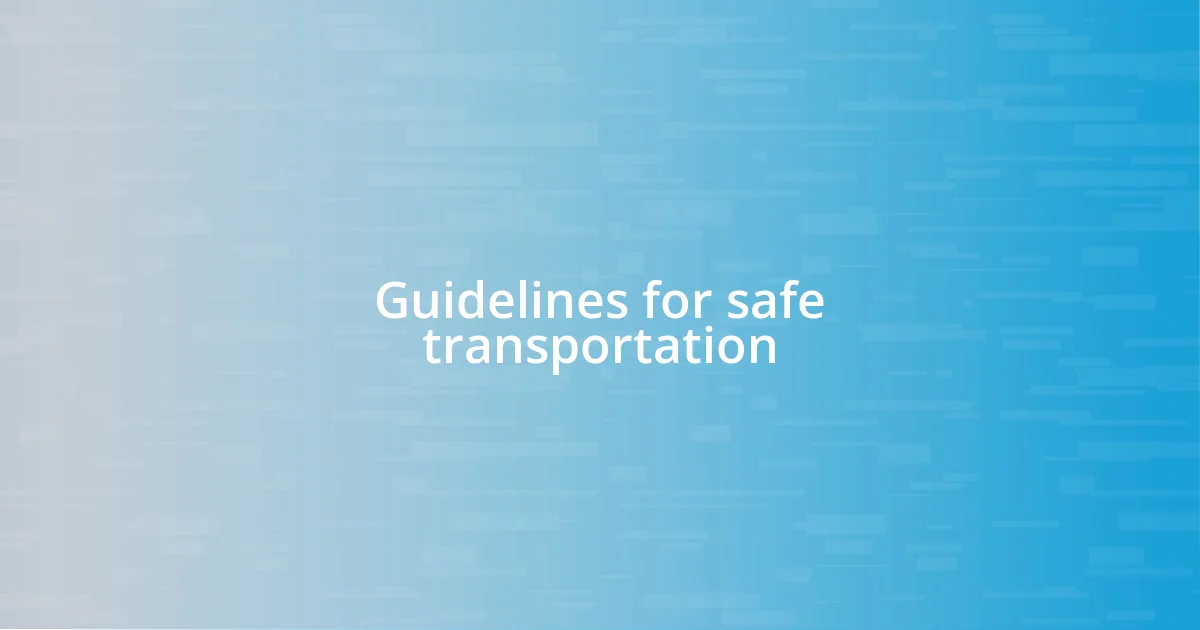
Guidelines for safe transportation
When it comes to safe transportation, planning ahead has always served me well. I remember a family road trip where we made a checklist of everything—seat belts, car seats for the little ones, and the importance of making frequent stops. It’s surprising how simple pauses for snacks and bathroom breaks not only keep everyone comfortable but also give us a chance to stretch our legs and shake off fatigue.
Additionally, I can’t stress enough the importance of vehicle maintenance before embarking on any journey. On one occasion, we experienced a flat tire in the middle of nowhere during a family vacation. Luckily, we took the time beforehand to ensure our car was in top shape, and even though we had a hiccup with the tire, we were prepared with a spare and tools. How often do we overlook the basics of checking tire pressure or oil levels? I’ve learned that investing a little time before the trip can save a whole lot of stress later on.
Finally, I find that discussing transportation rules with my kids transforms our travels into a fun learning experience. Before each trip, we set clear expectations about behavior in transit—like staying seated while the car is moving and using inside voices on public transport. Just the other week, after a long flight, we talked about why it’s vital to keep our belongings close and not to stray too far in crowded airports. Making it interactive, I turn these lessons into games, and the kids respond with enthusiasm. Doesn’t it feel great when you engage your children in a way that prepares them for responsibility?
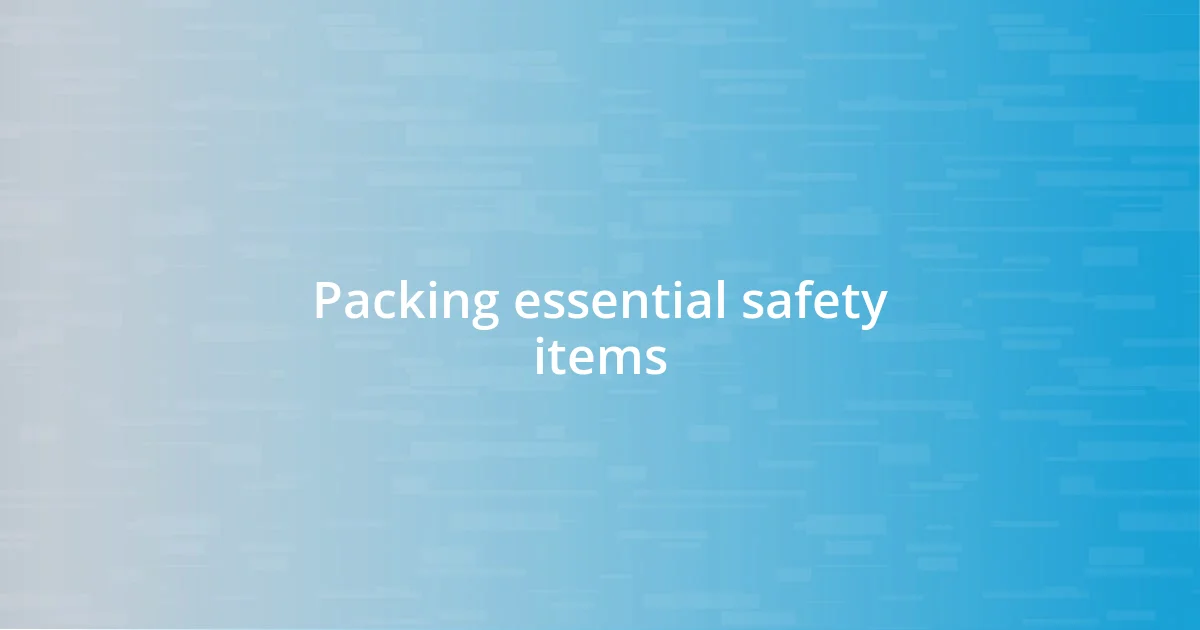
Packing essential safety items
Packing safety items is an art I’ve honed over the years. In my experience, a first-aid kit is a must-have. I remember a hiking trip when my child scraped their knee—having antiseptic wipes and band-aids on hand made all the difference. It was a simple moment, but knowing I could quickly address a small injury brought me immense peace of mind. Have you ever considered what you might need in an unexpected situation?
Besides the first-aid kit, I always include a small flashlight and extra batteries in our travel gear. On one family camping excursion, we had an unexpected power outage at night. It was a bit scary in the dark, but with our trusty flashlight, we could navigate safely and even found ourselves laughing over ghost stories. It’s little items like these that can turn a potentially frightening moment into one of bonding and fun. Don’t you find that having the right tools can change the atmosphere during a trip?
Lastly, I never forget to pack emergency contact information, especially when traveling with kids. One time, my youngest wandered off momentarily in a crowded market, and though they were quickly found, it reminded me how important it is to have a plan. I like to print out local emergency numbers and keep them in my wallet. The extra layer of preparation gives me a sense of control, even in unfamiliar places. Isn’t it comforting to know that you can always reach out for help if needed?
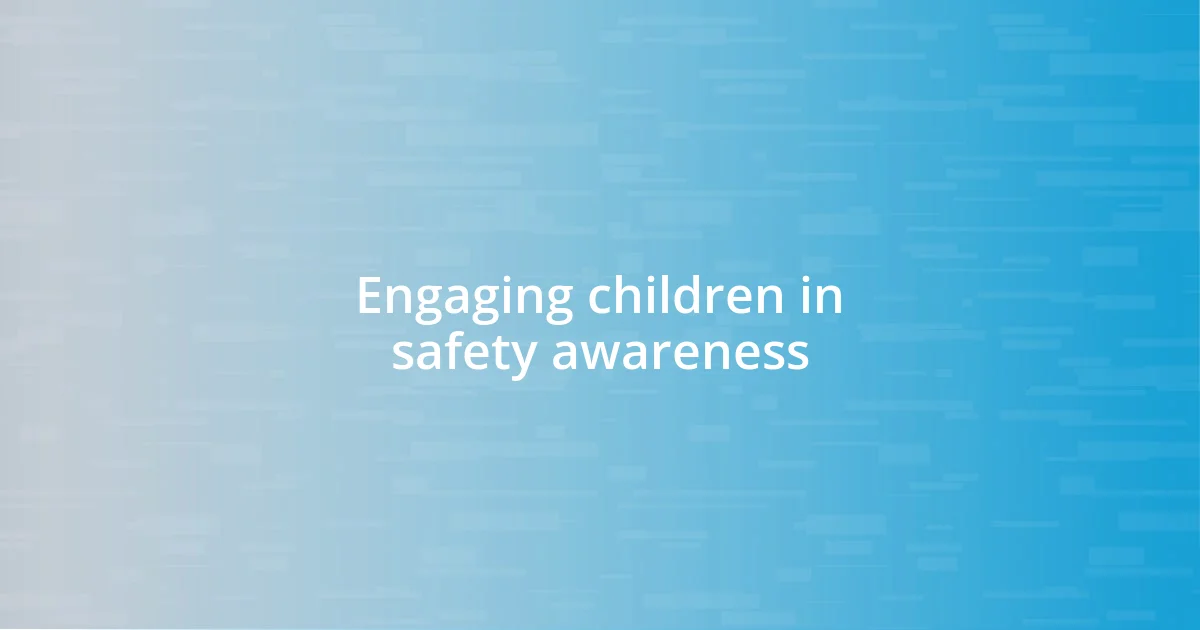
Engaging children in safety awareness
Engaging children in safety awareness can be both informative and fun. I recall a time when we made a “safety scavenger hunt” before a family trip. Each child took a list of safety items, and I had them spot things like fire extinguishers, emergency exits, and even first-aid kits in various locations. Watching their eyes light up as they found these items was a reminder that learning about safety doesn’t have to be boring—it can be an adventure!
Storytelling is another effective way to engage kids in safety discussions. During a car ride, I share entertaining tales about my own travel mishaps, like the time I forgot to fasten my seatbelt and learned the importance of safety the hard way. My kids love these anecdotes, and it opens the door for them to share their thoughts on what could have been done differently. Isn’t it amazing how a simple story can create a connection and reinforce an important lesson?
Additionally, I always incorporate role-playing into our safety training. For example, we practice what to do if we get separated in a busy place. I’ll pretend to wander off while they stay put and then discuss how to ask for help and recognize safe adults. I remember my child saying after one of these exercises, “I want to be brave like you, Mom!” That moment made me realize engaging them in these scenarios not only prepares them for real situations but also boosts their confidence. Wouldn’t you agree that empowering children with knowledge makes them feel more secure?


